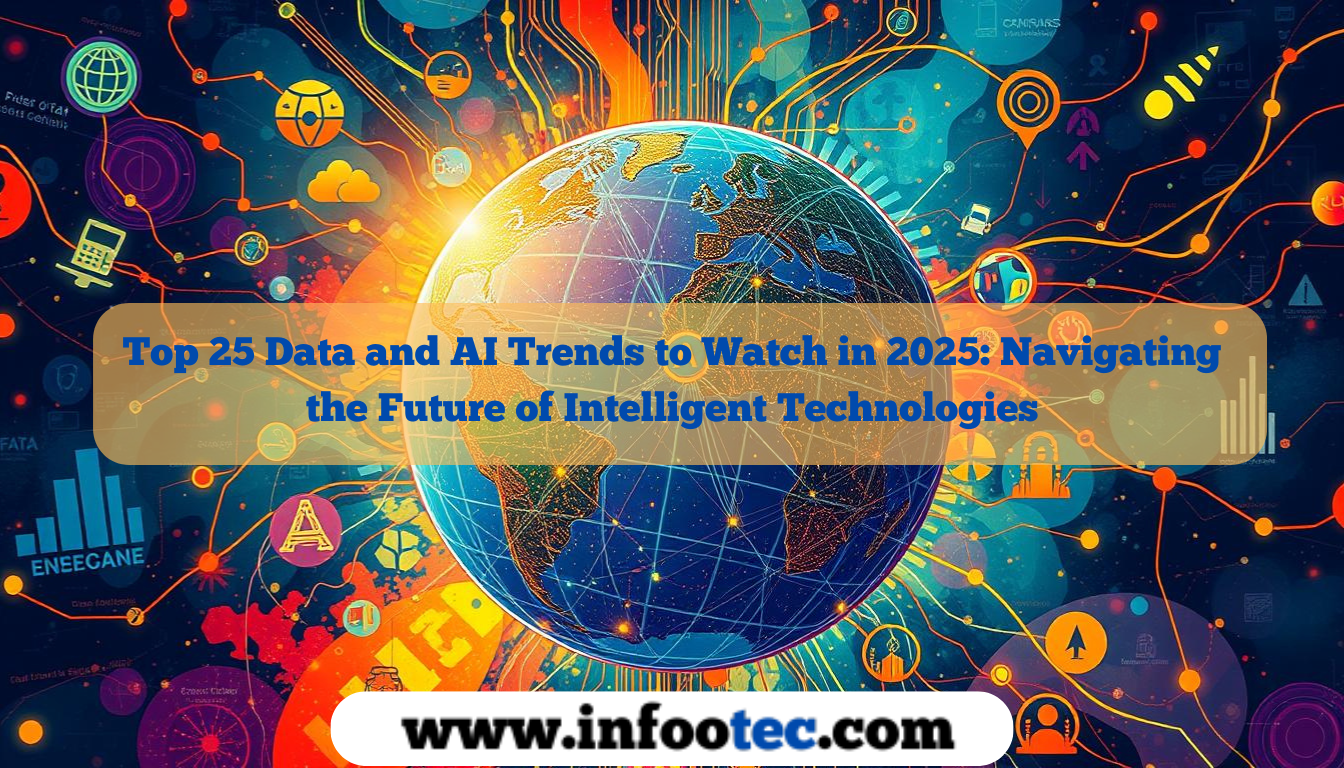Top 25 Data and AI Trends to Watch in 2025: Navigating the Future of Intelligent Technologies
As we progress through 2025, the fields of Data and Artificial Intelligence (AI) are evolving faster than ever, reshaping industries, business models, and daily life. A recent sector report highlights 25 major trends that will define the landscape of Data and AI this year. These trends reflect a maturing ecosystem where technological innovation meets ethical responsibility and sustainability.

This comprehensive article explores these key trends, providing insights into how organizations can leverage them to stay competitive and responsible in an increasingly data-driven world.
1. Massive Adoption of Generative AI for Process Automation and Analysis
Generative AI, which includes models capable of creating text, images, code, and more, continues its meteoric rise. Businesses across sectors are integrating generative AI to automate complex workflows, enhance content creation, and accelerate data analysis.
According to industry analyses, generative AI is becoming a cornerstone for innovation, enabling organizations to reduce manual effort while increasing creativity and operational efficiency. For example, marketing teams use AI to generate personalized campaigns, while software developers leverage AI for automated code generation and debugging.
2. Strengthening Data Governance and Ethics with Focus on Transparency and Compliance
With data privacy regulations like GDPR and CCPA tightening worldwide, organizations are prioritizing robust data governance frameworks. Transparency in data usage and ethical AI deployment are no longer optional but mandatory.
Companies are implementing advanced data cataloging, lineage tracking, and access controls to ensure compliance and build trust with customers and regulators. Ethical AI practices, including bias mitigation and explainability, are becoming integral to AI project lifecycles, ensuring AI decisions are fair and accountable.
3. Rise of Cloud Platforms for Real-Time Processing and Predictive Analytics
Cloud computing platforms continue to evolve, offering scalable, real-time data processing capabilities essential for modern analytics. Tools like Apache Kafka, Spark Streaming, and cloud-native services enable businesses to ingest, process, and analyze streaming data instantly.
Real-time analytics empower sectors such as e-commerce and finance to respond rapidly to customer behavior and market fluctuations, gaining competitive advantages. Predictive analytics, powered by AI, helps forecast trends, detect anomalies, and optimize operations proactively.
4. Automation through AutoML Democratizing AI Access
Automated Machine Learning (AutoML) platforms are simplifying AI model development, allowing non-experts to build, train, and deploy machine learning models efficiently. This democratization reduces the barrier to entry, enabling more teams to harness AI’s power without deep technical expertise.
AutoML accelerates innovation cycles by automating feature engineering, model selection, and hyperparameter tuning, making AI projects more accessible and cost-effective.
5. AI-Enhanced Security to Counter Cyber Threats in Real Time
Cybersecurity is increasingly augmented by AI to detect, analyze, and respond to threats faster and more accurately than traditional methods. AI-driven security systems monitor network traffic, identify unusual patterns, and automate incident responses, reducing the window of vulnerability.
As cyber threats grow in sophistication, AI-powered defense mechanisms become critical for protecting sensitive data and maintaining operational continuity.
6. Energy Optimization and Sustainability in Data Project Management
Sustainability is becoming a core concern in data and AI initiatives. Organizations are adopting energy-efficient algorithms, optimizing data center operations, and employing green computing practices to reduce the carbon footprint of their data projects.
Sustainable AI development includes minimizing redundant computations, cleaning datasets to reduce storage needs, and leveraging renewable energy sources, aligning technological progress with environmental responsibility.
7. Expansion of Agentic AI: Autonomous AI Agents Driving Business Processes
Agentic AI refers to autonomous AI systems capable of making decisions and performing tasks independently. These agents are increasingly used for customer service automation, supply chain management, and personalized recommendations, enhancing efficiency and user experience.
The rise of agentic AI represents a shift from AI as a tool to AI as an active participant in business workflows.
8. Multimodal AI Integrating Text, Image, and Video Data
Advancements in multimodal AI allow models to process and generate content across multiple data types simultaneously, such as combining text, images, and videos. This capability enhances applications in virtual assistants, content creation, and immersive experiences.
Models like GPT-4V and Gemini Ultra exemplify this trend, offering richer, more interactive AI-powered solutions.
9. Ethical AI and Explainability Becoming Industry Norms
As AI systems influence critical decisions, explainability and ethical considerations are paramount. Explainable AI (XAI) techniques provide transparency into model decisions, helping stakeholders understand and trust AI outputs.
Organizations are developing frameworks to ensure AI fairness, mitigate bias, and comply with emerging regulations, fostering responsible AI adoption.
10. AI-Augmented Workflows Boosting Productivity Across Industries
AI is increasingly embedded into workflows to automate routine tasks and provide predictive insights. In sectors like healthcare, finance, and manufacturing, AI tools improve accuracy, reduce costs, and accelerate decision-making, enabling professionals to focus on higher-value activities.
11. Growing Importance of Data Privacy Technologies
Technologies such as federated learning and differential privacy are gaining traction to protect sensitive data while enabling AI model training and analytics. These approaches allow organizations to collaborate and innovate without compromising individual privacy.
12. Increased Use of Synthetic Data for Training AI Models
Synthetic data generation helps overcome data scarcity and privacy concerns by creating artificial datasets that mimic real-world data. This trend supports AI model training in sensitive domains like healthcare and finance, where real data access is restricted.
13. Integration of AI in Edge Computing
Edge AI processes data locally on devices rather than relying solely on cloud infrastructure, reducing latency and bandwidth usage. This is critical for applications in IoT, autonomous vehicles, and real-time analytics.
14. Enhanced Collaboration Between Humans and AI
Human-in-the-loop AI systems combine human judgment with AI automation, improving accuracy and accountability. This collaborative approach is vital in areas requiring nuanced decision-making.
15. AI-Driven Personalization in Customer Experience
Personalized recommendations, dynamic content, and adaptive interfaces powered by AI enhance user engagement and satisfaction across digital platforms.
16. Adoption of AI in Regulatory Compliance and Risk Management
AI tools help organizations monitor compliance, detect fraud, and manage risks proactively, reducing legal exposure and operational losses.
17. Advances in Natural Language Processing (NLP)
NLP models continue to improve in understanding and generating human language, enabling better chatbots, translation services, and content analysis.
18. Growth of AI-Powered Analytics Platforms
Integrated analytics platforms combine data ingestion, AI modeling, and visualization, providing end-to-end solutions for business intelligence.
19. Increased Focus on Data Quality and Management
High-quality data is foundational for AI success. Organizations invest in data cleaning, enrichment, and governance to ensure reliable insights.
20. Expansion of AI Talent and Education Initiatives
As demand for AI expertise grows, educational programs and reskilling initiatives are expanding to fill the talent gap.
21. Use of AI for Environmental Monitoring and Climate Action
AI models analyze environmental data to support sustainability efforts, disaster prediction, and resource management.
22. Development of AI Standards and Frameworks
Industry consortia and regulators work on standards to ensure interoperability, safety, and ethical AI deployment.
23. Increased Investment in AI Startups and Innovation
Venture capital continues to flow into AI startups, driving innovation and new applications across sectors.
24. AI in Automation of Creative Industries
From music and art generation to automated video editing, AI is transforming creative workflows.
25. Growing Role of AI in Healthcare Diagnostics and Treatment
AI assists in medical imaging, diagnostics, and personalized treatment planning, improving patient outcomes.
Conclusion
The year 2025 is set to be transformative for Data and AI, marked by widespread adoption of generative AI, strengthened governance and ethics, cloud-powered real-time analytics, and sustainable practices. Organizations that embrace these trends will unlock new efficiencies, foster innovation, and build trust with stakeholders.
By staying informed and agile, businesses can harness the full potential of Data and AI to drive growth and societal benefit in the coming years.



